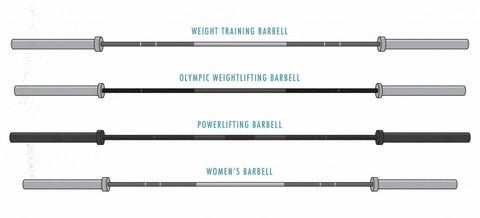Have you ever picked up a barbell and wondered exactly how much it weighs? Knowing the weight of a standard barbell is key to tracking your progress and planning your workouts effectively.
Whether you’re just starting out or looking to improve your lifting routine, understanding this simple fact can make a big difference. Keep reading to discover the exact weight of a standard barbell and how this knowledge can help you lift smarter and reach your fitness goals faster.

Standard Barbell Weight
Standard barbells are common in home gyms and some fitness centers. They have a fixed weight that many people want to know about before starting their workouts.
This article explains the usual weight of a standard barbell and compares it with other types.
Common Weight Specifications
A standard barbell usually weighs less than Olympic barbells. Most standard barbells weigh around 15 pounds. The length is about 5 to 6 feet.
- Weight: 15 pounds (6.8 kg)
- Length: 5 to 6 feet (1.5 to 1.8 meters)
- Diameter: 1 inch (25 mm)
- Material: Steel or chrome-plated steel
- Loadable sleeves for weight plates
Differences Between Standard And Olympic Barbells
Standard and Olympic barbells look similar but have key differences. Olympic barbells are heavier and longer. They also have thicker sleeves.
| Feature | Standard Barbell | Olympic Barbell |
|---|---|---|
| Weight | 15 pounds (6.8 kg) | 45 pounds (20.4 kg) |
| Length | 5 to 6 feet | 7 feet (2.2 meters) |
| Sleeve Diameter | 1 inch (25 mm) | 2 inches (50 mm) |
| Use | Home gyms, light workouts | Professional lifting, competitions |
| Weight Plates Fit | Standard plates | Olympic plates |

Materials And Construction
Standard barbells are built to support heavy weights safely. Their materials and construction affect strength and durability. This makes them reliable for many types of workouts.
The choice of steel and design features help improve performance. These factors also influence the barbell’s weight and grip feel.
Types Of Steel Used
Most barbells use steel because it is strong and long-lasting. Different types of steel can change the barbell’s quality and price.
- Stainless Steel: Resists rust and has a smooth finish.
- Carbon Steel: Very strong and common in many barbells.
- Alloy Steel: Includes other metals to increase strength and flexibility.
- Chrome Steel: Has a shiny surface and offers good protection against corrosion.
Knurling And Grip Features
Knurling is the textured pattern on a barbell’s grip area. It helps lifters hold the bar firmly without slipping.
| Knurling Type | Description | Purpose |
|---|---|---|
| Light Knurling | Shallow pattern | Comfortable grip for high-rep workouts |
| Medium Knurling | Standard depth | Good balance of grip and comfort |
| Aggressive Knurling | Deep and rough pattern | Strong grip for heavy lifts |
Some barbells also have marks on the knurling. These marks help lifters place their hands correctly for certain exercises.
Variations By Barbell Type
Barbells come in different types and weights. Knowing the weight helps with training and safety.
The weight depends on the barbell’s design and purpose. Let’s explore the common types.
Men’s And Women’s Barbells
Standard barbells for men and women have different sizes and weights. Men’s barbells are usually longer and heavier.
| Barbell Type | Length | Weight |
|---|---|---|
| Men’s Barbell | 7 feet (2.13 meters) | 45 pounds (20.4 kg) |
| Women’s Barbell | 6.5 feet (2 meters) | 33 pounds (15 kg) |
Specialty Barbells And Their Weights
Specialty barbells have unique shapes and uses. Their weights vary to match their purpose.
- Trap Bar: About 55 pounds (25 kg), used for deadlifts.
- EZ Curl Bar: Around 20 pounds (9 kg), for arm exercises.
- Swiss Bar: Roughly 25 pounds (11 kg), for shoulder and chest training.
- Safety Squat Bar: Approximately 60 pounds (27 kg), eases shoulder strain.
Factors Affecting Barbell Weight
The weight of a standard barbell depends on several factors. These factors affect how much the barbell weighs and how it feels during use.
Understanding these factors helps you choose the right barbell for your workouts and goals.
Barbell Length And Diameter
Barbells come in different lengths and diameters. The size affects the total weight of the barbell.
| Barbell Type | Length (feet) | Diameter (inches) | Typical Weight (lbs) |
| Standard Barbell | 5-6 | 1 | 15-25 |
| Olympic Barbell | 7 | 2 | 44-45 |
| Women’s Olympic Barbell | 6.5 | 1.85 | 33-35 |
Longer barbells usually weigh more. Thicker bars may also increase weight and affect grip comfort.
Sleeve Design And Bearings
The barbell sleeves hold the weight plates. Their design changes the barbell’s total weight and how smoothly it spins.
- Solid Sleeves:These sleeves do not spin. They add less weight but can cause more strain on wrists.
- Sleeves with Bushings:These have small bearings to help the sleeves spin smoothly. They add a little weight.
- Needle Bearings:These allow the sleeves to spin very freely. They add some weight but improve lifting safety.
Choosing the right sleeve design depends on your lifting style and needs. Spinning sleeves reduce stress on your joints.
Choosing The Right Barbell Weight
Picking the right barbell weight is key for safe and effective workouts. The standard barbell weight affects your performance and progress.
Consider your fitness goals and experience before choosing. The right weight helps you train smarter and avoid injury.
Fitness Goals And Experience Level
Your fitness goals and how long you have trained guide your barbell choice. Beginners need lighter bars to learn form. Experienced lifters can handle heavier bars.
- Beginners:Start with a standard 20 kg (44 lb) barbell or lighter training bars.
- Intermediate:Use the standard barbell weight to build strength safely.
- Advanced:Choose heavier barbells or specialty bars for specific lifts.
- Goal-focused:Adjust barbell weight based on muscle building or endurance training.
Home Gym Vs Commercial Gym Use
Where you train affects the barbell weight you should pick. Home gyms have space and budget limits. Commercial gyms offer many barbell options.
| Gym Type | Barbell Weight | Reason |
| Home Gym | Standard 20 kg (44 lb) | Fits most workouts and space |
| Home Gym | Lighter 10-15 kg bars | Easier for beginners and smaller spaces |
| Commercial Gym | Standard 20 kg (44 lb) | Used for most lifts and classes |
| Commercial Gym | Specialty Bars (heavier or lighter) | Supports varied training needs |
Maintenance And Weight Consistency
Standard barbells usually weigh 20 kilograms or 45 pounds. Keeping them in good shape helps keep their weight consistent. Regular maintenance prevents damage and wear.
Weight consistency is important for safe and effective workouts. Changes in weight can affect your lifting progress and technique.
How To Keep Your Barbell In Shape
Cleaning and storing your barbell properly extends its life. Use light oil on the sleeves and shaft to stop rust. Avoid dropping the barbell on hard surfaces.
- Wipe down the barbell after each use
- Apply oil to moving parts monthly
- Store in a dry place away from moisture
- Check for loose or damaged parts regularly
- Avoid dragging the barbell on rough floors
Impact Of Wear On Barbell Weight
Wear can change the barbell’s weight over time. Rust and dirt add small weight, while damage or bending may reduce it. Regular inspections help catch these issues.
| Type of Wear | Effect on Weight |
| Rust Build-up | Increases weight slightly |
| Dirt and Dust | Minor weight increase |
| Bending or Damage | May reduce weight |
| Worn Sleeves | Changes rotation, affects feel |
| Loose Collars | Unsafe, may cause weight shifts |

Frequently Asked Questions
What Is The Weight Of A Standard Barbell?
A standard barbell typically weighs 45 pounds (20. 4 kilograms). This weight is common in gyms worldwide and suits most strength training exercises.
Are There Different Weights For Barbells?
Yes, barbells come in various weights. Standard barbells usually weigh 45 pounds, while women’s and specialty bars weigh less.
How Heavy Is An Olympic Barbell?
An Olympic barbell weighs 44 pounds (20 kilograms). It is slightly lighter than a standard barbell but designed for Olympic lifting.
Can Standard Barbells Be Used For All Exercises?
Standard barbells are versatile and suitable for most weightlifting exercises. However, some specific lifts may require specialty bars.
Conclusion
Understanding barbell weights helps in planning workouts better. Standard barbells usually weigh 45 pounds. This is common in gyms. It’s important to know this for safety. Beginners can start with lighter weights. Progress comes with time and practice. Always check the weight before lifting.
This avoids injuries. Accurate knowledge helps reach fitness goals. Stay informed. Stay safe. Keep lifting and improving.



